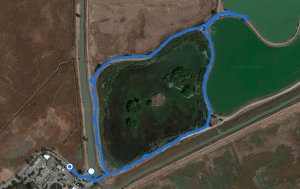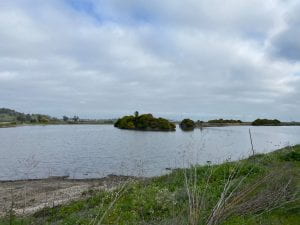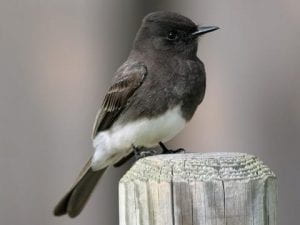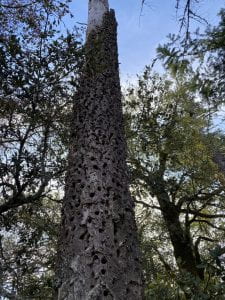Uncategorized
Field Journal #7
Date: Tuesday, March 24, 2020
Location: San Leandro, CA (37.71186, -122.12707)
Site description: My siting location for this field journal was my boyfriend’s backyard in San Leandro. The land is elevated in the hills, so it overlooks the East Bay. The surrounding area was suburban, the backyard was an open area with some shrubbery and patchy, dry land. It started drizzling halfway through our time in the backyard, which made the ground slightly muddy. Along the fences of the backyard were large chicken coops that took up a great amount of the area. I would describe the site as crowded, but also open. Crowded because there was a lot of clutter in the backyard, but the area was big enough where there were empty spaces. The key species I saw often were the Rock Pigeon, American Crow, and Common Raven.
Species account: A species not native to the Western hemisphere that I encountered was the Red Junglefowl (Gallus gallus). This species is in the order Galliformes and family Phasianidae. The reason why I saw a large number of these is because my boyfriend’s dad breeds them in their backyard and sends them back to the Philippines to be sold. Fully matured adults were kept in large coops in the backyard while chicks were kept in an open area under an elevated porch. I found the species very vocal as I had a hard time concentrating on my other work. The call of a rooster is very distinct, and they often have different calls for different reasons, for example they have a different call for food then they do when warning others of an aerial predator. They are generally smaller in size, and roosters have bright, contrasting colors with dark, almost iridescent tail feathers. I was told they express a dominant, skittish-like behavior. They are native birds to South and Southeast Asia and are often found in areas with open ground and dense vegetation. They are largely omnivorous, and their diet consists mainly of insects and seeds.
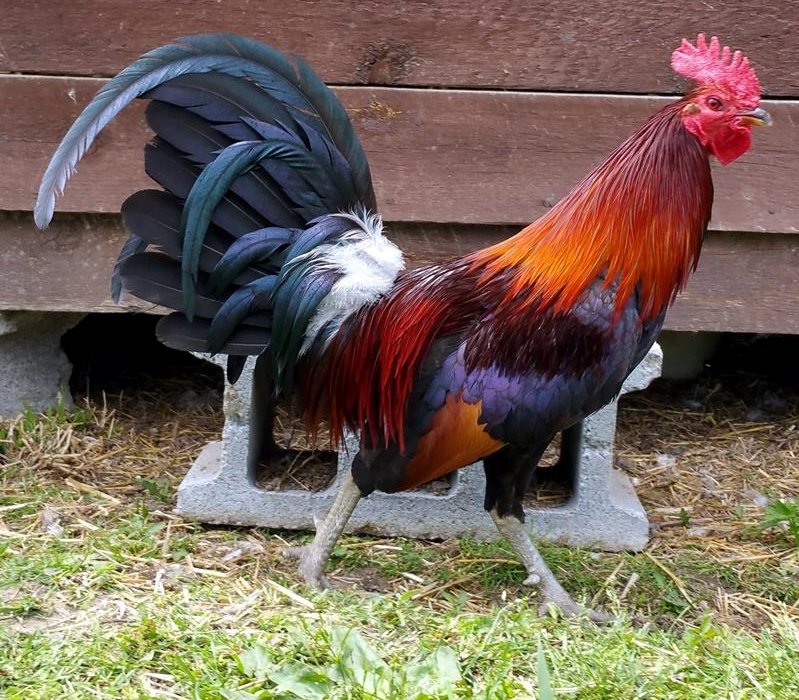
Narrative: The majority of the time was spent sitting in the backyard because of the quarantine. In total, I only saw five species, and nothing I hadn’t seen before (with the exception of the junglefowl). The weather was cloudy and it was slightly cold, and we actually left the backyard because it started raining pretty hard. I think a large part of why I didn’t see any new species was because I was primarily in a suburban area, where everything was more busy and the habitat was not ideal for many species. However, it was nice being able to quickly identify the ones we had seen many times. We went for a drive across the bay to drop someone off, where I was only able to see gull species in the sky due to the rain. Overall, I wish I was able to see some new species, but I’m glad that I’m comfortable being able to identify the ones we’ve seen multiple times.
eBird checklist: https://ebird.org/checklist/S66186502?share=true
Citations:
“Red Junglefowl Gallus Gallus.” Red Junglefowl – Introduction | Neotropical Birds Online, neotropical.birds.cornell.edu/Species-Account/nb/species/redjun/overview.
Guan, Peter Yew. “Red Junglefowl.” Infopedia, National Library Board Singapore, 21 Aug. 2001, eresources.nlb.gov.sg/infopedia/articles/SIP_541_2004-12-24.html.
Field Journal #6
Date: Thursday, March 5, 2020
Location: Las Gallinas Valley Sanitary District, 309 Smith Ranch Rd, San Rafael, US-CA (38.02576, -122.51761)
Site descriptions: Our sighting location was a sanitation district in San Rafael. We started in the parking lot, where we saw a number of Red-winged Blackbirds and Brewer’s Blackbirds perched on telephone lines above. We walked towards a paved path that circled around numerous ponds of recycled water. Along the pathways were shrubs and some trees outlining each pond. The area was somewhat marsh-like with a variety of shorebirds and ducks. In the center of some ponds were islands covered with trees, which were some great spots to see different species. On the opposite sides of the ponds were long fields of grass and shrubbery. Some of the key species we saw were the Northern Shoveler, Mallard, Red-winged Blackbird, Marsh Wren, Canada Goose, Common Gallinule, and Tree Swallow. In total, I saw 40 species.
Species account: A species we observed throughout our field lab was the Black-crowned Night-Heron (Nycticorax nycticorax). This species is in the order Pelecaniformes and family Ardeidae. We first saw this bird perched on a tree branch on the island pictured above. I saw a great amount of these hanging around in the trees in close proximity to one another, and I was able to observe them in great detail through the scope because they stayed fairly still. The Night-Heron was a pretty chunky, pale bird with a black-colored back and cap. One thing I noticed was that it seemed fairly petite, as its head was almost continuous with its body. The first Night-Heron I encountered was sleeping, and its head was tucked slightly the side with its eyes closed. Later, I was able to see that Night Herons have dark red eyes and long, yellow limbs that they use to crouch under brunches in the daytime. They are most active at night or at dusk, and feed on fish, frogs, and many other terrestrial, freshwater, and marine prey with their long, dark and pale yellow bill. They require an aquatic habitat for foraging and terrestrial habitats for cover. Black-crowned Night Herons are often found in wetlands across North America, however they do have a worldwide distribution. Both males and females are extremely territorial, defending both their feeding and nesting areas by striking each other with their bills and grabbing each other’s wings. Even so, Night Herons are social year-round and nest colonially. Males often court females by bowing and raising the long, dark feather on its head. Both males and females take part in incubating the egg and taking care of the chicks. Male and female partners communicate with each other with calls and raised feathers.
Narrative: During this trip, I observed a total of 40 species in a timeframe of about 2 hours 49 minutes, which was the highest number I’ve seen throughout all our field labs. The weather was partly cloudy with the sun often shining through the clouds. It wasn’t very windy or cold. I found that the sanitation district was a popular place to observe a great number of species. We saw a group of American White Pelicans in the distance, and a couple that walked by our group said that this species came back after not being seen in this area for a period of time. We saw an abundant amount of ducks and geese in these ponds. It was difficult to ID new species just by lookng at them, but I found it helpful to use my Sibley V2 field guide to help verify the species. This was definitely helpful when thinking about studying for the field quiz and final. The majority of our time spent here was walking around the ponds and identifying new species according to our field guide. Many birds were seen through the scope in great detail, including the White-tailed Kite, which I saw perched on the field for quite some time. One lady said she had spent since January looking for a species called the Blue-winged Teal, which we luckily saw at the very end of our trip walking back to the cars.
eBird checklist: https://ebird.org/checklist/S65463830?share=true
Citations:
“Black-Crowned Night-Heron Overview, All About Birds, Cornell Lab of Ornithology.” Overview, All About Birds, Cornell Lab of Ornithology, www.allaboutbirds.org/guide/Black-crowned_Night-Heron/overview.
“Black-Crowned Night-Heron.” Audubon, 5 Nov. 2019, www.audubon.org/field-guide/bird/black-crowned-night-heron.
Field Journal #5
Date: Thursday, February 27, 2020
Location: Muir Beach, CA (37.86126, -122.57530)
Site descriptions: Our sighting location was a trail by Muir Beach. About a half-mile from the coast, we walked through an area with lots of shrubbery and willows. Although the land was mostly dry, we walked across an empty patch of grass (pictured below) during one instance to identify a species. Some of the key species we saw were the American Crow, Black Phoebe, and four different species of sparrows.
Species account: A new species we came across for the first time was the Black Phoebe (Sayornis nigricans). This species is in the order Passeriformes and family Tyrannidae. We first came across this species at the beginning of our walk, and we were able to observe it in great detail sitting above a willow tree. Black Phoebes are fairly small, plump birds with large heads, a long, squared tail, and straight, thin bills. They have blackish-brown plumage on the upperparts and chest, with a darker head. Their underside is typically white. A behavior I observed from this species is their tendency to flick their tails up and down when perched. We observed this behavior when one bird was perched on a wooden fence, most likely keeping an eye out for prey. This species is found near water, along streams, lakes, and rivers where mud can be used for nest building Their diet mainly consists exclusively of insects and other arthropods. Pairs of Black Phoebes are often territorial and will chase away others of the same species as well as other birds. They are also monogamous, and males and females are usually together for upwards of five years.
Narrative: During this trip, I observed a total of 26 species, which was the most I’ve seen in any of our past field labs. The weather was slightly breezy, but mainly clear skies. Initially, we didn’t make it far in our walk the first hour due to us seeing an abundance of new species. There was on point in the trip where we came across four different species of sparrows on the ground: the Fox Sparrow, White-crowned Sparrow, Lincoln’s Sparrow, and Song Sparrow. They were very hard to distinguish at first because of their similarity in color and pattern, but I was eventually able to spot the differences in plumage. Besides our usual species observed (Anna’s Hummingbird, Turkey Vulture, American Crows), we were able to identify so many more. I believe this was mainly due to the weather and the close proximity to water. Near the end of our trip, we walked to an overlook by the beach and were able to see some seabirds using the scope (and dolphins!)
eBird checklist: https://ebird.org/checklist/S65220931?share=true
Citations:
“Black Phoebe Life History, All About Birds, Cornell Lab of Ornithology.” , All About Birds, Cornell Lab of Ornithology, www.allaboutbirds.org/guide/Black_Phoebe/lifehistory.
Field Journal #4
Date: Thursday, February 20, 2020
Location: Mount Tamalpais, Mill Valley, CA (37.91435, -122.60926)
Site descriptions: Our sighting location was an area on Mount Tamalpais. The habitat was a mixed coniferous forest with many Douglas firs and oaks. The terrain and surrounding area seemed fairly dry. Some of the key species found in this area were Acorn Woodpecker, Dark-eyed Junco (Oregon), and the Northern Flicker (Red-shafted).
Species account: A species we came across for the first time was the Acorn Woodpecker (Melanerpes formicivorus). This species belongs to the order Piciformes and family Picidae. We first saw this species when we walked to an outdoor amphitheater pictured above, where they were flying from tree to tree and perched on a wooden fence. A feature that makes them distinct is their clownish face and red plumage. Males typically have a red cap and whiteish forehead, where females have a black cap and the red is restricted to the back of the head. They are medium-sized birds with straight, spikey bills and wedged tailed that are used for support. Acorn Woodpeckers live in large groups and often gather acorns and hide them in self-made holes in tree trunks (pictured below). We learned that these birds have great memory, as they are able to remember the exact place where each acorn is stored. Often throughout the time spent at Mount Tamalpais, we heard their loud, squeaky calls. These woodpeckers live in oak forests in the Southwest and West Coast.
Narrative: During this trip, we walked along a clear trail on Mount Tamalpais, surrounded by a variety of tall trees. I noticed that many of the trees were dead oaks with holes, indicating the presence of Acorn Woodpeckers nesting or hiding acorns. The weather was clear, the sun was out, and there was slight to no wind. We did not see many species or new species compared to our last few trips. I mainly observed birds we had come across before, such as Chestnut-backed Chickadees, Dark-eyed Juncos, and Common Ravens. The only new species we saw were the Acorn Woodpeckers, Band-tailed Pigeon, and Northern Flicker, which was surprising because the weather was very nice out.
eBird checklist: https://ebird.org/checklist/S65160680?share=true
Work Cited:
“Acorn Woodpecker Identification, All About Birds, Cornell Lab of Ornithology.” , All About Birds, Cornell Lab of Ornithology, www.allaboutbirds.org/guide/Acorn_Woodpecker/id?gclid=EAIaIQobChMIm8i9oor75wIVFq5kCh1kGQabEAAYASAAEgK-wPD_BwE.
“Acorn Woodpecker.” Audubon, 11 Oct. 2019, www.audubon.org/field-guide/bird/acorn-woodpecker.
Field Journal #3
Date: Thursday, February 13, 2020
Location: Bolinas Bay, Marin, CA (37.90484, -122.65189)
Site descriptions: Our sighting locations were by the coast of Bolinas Bay. The area was marsh-like and mostly covered in water. Not many trees were nearby, but our main sightings were seabirds and mallards. Some of the key species included the American Wigeon, Long-billed Curlew, Snowy Egret, and Nothern Pintail.
Species account: A species we came across towards the end of the trip was the Great Blue Heron (Ardea herodias). This species was easily observable because of its large size, long neck, and legs. The grey/dark-blue plumage was distinguishable along with its sharp yellow bill. When we came across this species, it remained still in the same spot in water for nearly 10 minutes with slight to no movement. Great Blue Herons often forage in shallow wetlands and wait for fish to spear with its long bill. Besides fish, herons eat nearly anything within striking distance, including amphibians, reptiles, small mammals, insects, and other birds. They use their strong mandibles to grab prey in a quick, swift motion. This species regularly forages alone. Great Blue Herons nest mainly in trees. Males first settle on nest sites and court passing females, who have a clutch size of about 4-6 eggs. Both parents take turns incubating the eggs for 4 weeks.
Narrative: During this trip, we remained close to the coastline, along the wetlands of the Marin. We drove to a few spots around Bolinas Bay, many with the same type of wetland ecosystem. The weather was cloudy and the air was cold. We came across numerous species of ducks, which were difficult to distinguish at first, but after pointing out differences, we were able to identify more than five species. We were able to see an Osprey, which stayed perched on a wooden stake for a long period of time.
eBird checklist: https://ebird.org/checklist/S64424354?share=true
Work Cited:
“Great Blue Heron.” NatureMapping, naturemappingfoundation.org/natmap/facts/great_blue_heron_k6.html.
“Great Blue Heron Life History, All About Birds, Cornell Lab of Ornithology.” , All About Birds, Cornell Lab of Ornithology, www.allaboutbirds.org/guide/Great_Blue_Heron/lifehistory.
Field Journal #2
Date: Thursday, February 6th, 2020
Locations: Mount Tamalpais State Park, Mill Valley, CA (37.8796,-122.5548)
Marin, CA (37.8671, -122.5804)
81 Seascape Dr, Muir Beach, CA (37.8629,-122.5851)
Site descriptions: We went to three different sites in Marin county. The first, Mount Tamalpais State Park, had an almost elevated terrain with a wide variety of shrubs and conifers. We walked through an open dirt path up to a clearing with lots of shrubs. Our second location was about a mile down from where we started. We stopped at an empty dirt road with large coniferous trees and a stream that used to hold salmon. Our third location was an overlook by Muir Beach. This location was on a cliff and allowed us to see high-flying species such as turkey vultures.
Species account: A species we came across multiple times within our trip was the Wrentit (Chamaea fasciata). Although I only observed the species once within the outing, I was able to recognize it with its distinct call various times. As they tend to linger inside shrubs, we mostly relied on their call to locate them. They were often heard and seldom seen. Their call resembled a ping-pong ball being dropped on a table. It was difficult to see as its brown-grey plumage allowed it to blend in with its habitat. Wrentits are fairly small birds with large, round heads, long legs, and pointed tails which are often held at different angles. With a diet of mostly insects and berries, they tend to forage in dense low brush. In regards to nesting, they have the ability to mate for life. Pairs typically remain together on nesting territories during all seasons. Nestlings are often fed by both parents, and they leave the nest about 15-16 days after hatching.
Narrative: We went to three different locations during this trip, seeing some common birds within the three areas and some different. We noticed the presence of some species, such as Allen’s Hummingbird and Anna’s Hummingbird, at our first location, but failed to see any at our second. This made me think that this was perhaps due to elevational differences. At our third location, we overlooked the ocean and were able to get a better look at some turkey vultures. Because we were at an overlook, we saw a variety of species that tend to perch on top of trees and those who like to nest near the seacliffs.
eBird Checklist:
https://ebird.org/checklist/S64180409?share=true
https://ebird.org/checklist/S64182216?share=true
https://ebird.org/checklist/S64183486?share=true
Citations:
“Wrentit Identification, All About Birds, Cornell Lab of Ornithology.” , All About Birds, Cornell Lab of Ornithology, www.allaboutbirds.org/guide/Wrentit/id.
“Wrentit.” Audubon, 11 Oct. 2019, www.audubon.org/field-guide/bird/wrentit.
Field Journal #1
Date: Thursday, January 30, 2020
Location: Golden Gate Park, San Francisco, CA (37.7742, -122.4552)
Site description: Corner of Golden Gate Park, near main roads. The area was dry with a variety of conifers. We walked on a clear path that led to some higher elevated openings. The key bird species found in this area were the Common Raven, Bushtit, Golden-crowned Sparrow, and Dark-eyed Junco.
Species account: Anna’s Hummingbird (Calypte anna) was one species we came across several times on our walk through Golden Gate Park. This species has a green and grey colored body, with males having a distinguishable magenta-red throat that may appear dull brown or gray without direct sunlight. Being the smallest bird we encountered (only a few inches), it was difficult to capture a look at them while they flew from tree to tree. Often, we encountered this particular species in open areas within the city park limits that still had an abundant amount of conifers. With their territorial behavior, males defend their feeding areas and chase away other competitors, as we saw multiple times throughout the walk. We observed that the males hover in midair, fly to a much higher altitude, then dive steeply towards the female as a courtship display. The diet of Anna’s Hummingbird mostly consists of nectar and insects, however, they will feed on sugar-water mixtures in hummingbird feeders. This species is a permanent resident along the Pacific Coast and often stay through the winter in many areas where no other hummingbirds are present. They are significantly more vocal than most hummingbirds, males having a buzzy song often given when perched.
Narrative: This was our first day on the field. We walked to the edge of Golden Gate Park and stayed in close proximity to the main streets for the whole two hours, not going too far into the park itself. We started observing species at approximately 10:10 am, the weather being slightly foggy, with not much wind or sunlight. About an hour into our treck, we came across a few people who were also birding. They mentioned that they had supposedly seen a Red-naped Sapsucker, which had not been seen in the area since the ’80s. Whether this was an actual Red-naped Sapsucker or a different type of Sapsucker is unknown. In total, we came across 13 different species. In the first 30 minutes of our trip, it was difficult to spot where a bird was when somebody pointed it out. Additionally, it was hard to capture what the bird looked like unless it was perched on a branch.
eBird Checklist: https://ebird.org/checklist/S63942215?share=true
